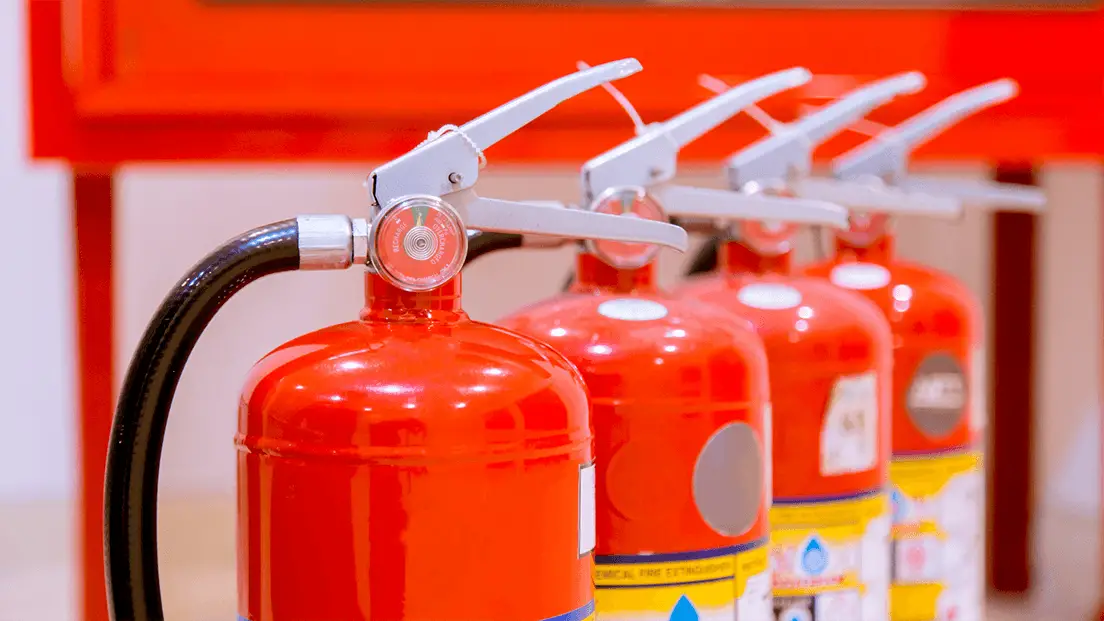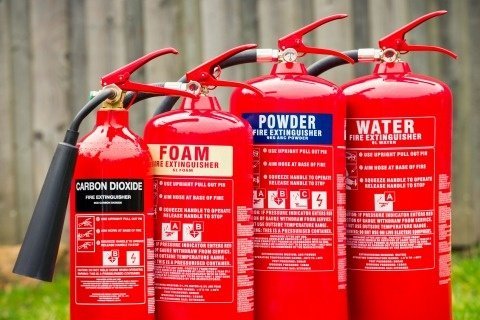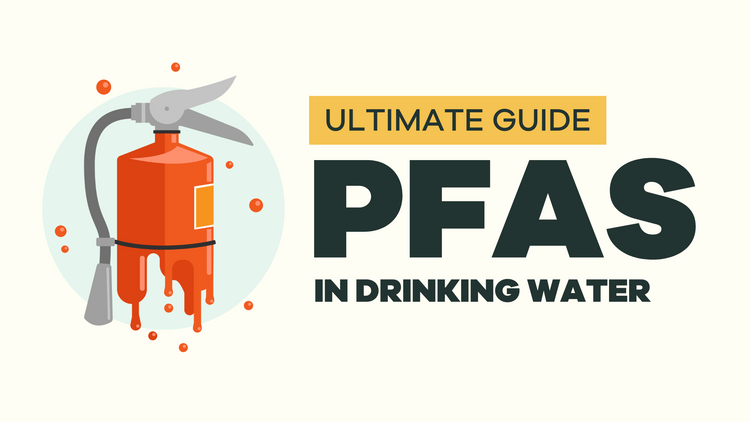A business premises typically requires fire extinguishers based on its size and fire risk level. The general rule is to have at least one fire extinguisher for every 2,500 square feet of space.
Additionally, it is recommended to have a minimum of one fire extinguisher on each floor of the building. Proper placement and maintenance of fire extinguishers are crucial to ensure fire safety compliance and preparedness within the business premises. By following these guidelines, businesses can enhance their ability to effectively respond to fire emergencies and protect both occupants and property.
Fire extinguishers play a critical role in preventing and controlling fires, making them an essential safety measure for all types of business establishments.

- The Importance Of Fire Safety Regulations
- Determining The Number Of Fire Extinguishers
- Understanding Fire Extinguisher Classes
- Placement And Maintenance Of Fire Extinguishers
- Employee Training And Emergency Preparedness
- Frequently Asked Questions Of How Many Fire Extinguishers Are Required In A Business Premises
- Conclusion
The Importance Of Fire Safety Regulations
Ensuring Compliance With Legal Requirements
Businesses must adhere to fire safety regulations by having the required number of fire extinguishers on their premises.
- Regulations dictate the minimum quantity of fire extinguishers based on the size and fire risk of the premises.
- Having sufficient fire extinguishers ensures compliance with the law and protects occupants and property.
Minimizing Risk Of Property Damage And Injury
Proper fire safety measures minimize the chances of property damage and injuries resulting from fires.
- Strategically placed extinguishers can suppress small fires before they escalate.
- Reducing fire risks enhances the overall safety of the premises and its occupants.

Credit: www.blakefire-security.co.uk
Determining The Number Of Fire Extinguishers
Assessing The Size And Layout Of The Business Premises
Before deciding on the number of fire extinguishers needed, evaluate the size and layout of the premises.
Evaluating Different Fire Hazards
Next, consider the various fire hazards present in the business to determine the appropriate number of fire extinguishers.
Understanding Fire Extinguisher Classes
Business premises must have an adequate number of fire extinguishers, depending on the potential fire hazards. Understanding the different fire extinguisher classes helps in determining the required quantity for each area of the premises, ensuring the safety and protection of employees, customers, and property.
Understanding Fire Extinguisher Classes When it comes to fire safety in a business premises, one of the most important elements is having the right fire extinguishers on hand. Fire extinguisher classes are based on the types of fires they are designed to combat, and each class is specifically suited to a certain type of fire. Understanding the different classes of fire extinguishers is essential for ensuring that your business premises is adequately equipped to handle all potential fire hazards. Let’s delve into the specifics of each fire extinguisher class. Class A: Ordinary Combustibles Class A fire extinguishers are designed to tackle fires involving ordinary combustible materials such as wood, paper, cloth, and other common combustibles. These are the most common type of fire and can occur in most business premises. Having Class A fire extinguishers strategically placed throughout the premises is crucial for effectively addressing these types of fires. Class B: Flammable Liquids and Gases Class B fire extinguishers are specifically designed for fires involving flammable liquids and gases, such as gasoline, oils, grease, and other similar substances. These types of fires can occur in settings where such materials are used or stored, making it important to have the appropriate fire extinguishers readily available to address these hazards. Having the right fire extinguisher classes in place is essential for maintaining a safe and compliant business premises. By understanding the specific uses of each class of fire extinguisher, you can ensure that your premises is adequately equipped to handle any potential fire emergencies that may arise.Placement And Maintenance Of Fire Extinguishers
When it comes to fire safety in a business premises, the placement and maintenance of fire extinguishers play a crucial role in preventing and managing fire incidents. Properly located extinguishers and regular inspection are essential to ensure the safety of employees, customers, and property. In this section, we will discuss strategic locations for accessibility, as well as the importance of regular inspection and servicing.
Strategic Locations For Accessibility
Strategically placing fire extinguishers throughout your business premises is vital for quick and easy access during emergencies. Consider the following guidelines for ensuring accessibility:
- Identify high-risk areas: Begin by identifying areas where fire hazards are most likely to occur. These areas include kitchens, server rooms, electrical panels, and workshops.
- Keep it visible: Install fire extinguishers in prominent locations that are easily visible and identifiable. They should be placed at eye level and not hidden behind furniture or other obstructions.
- Prioritize proximity: Ensure that fire extinguishers are placed in close proximity to areas where the risk of fire is high. For instance, the kitchen area should have a fire extinguisher within a few feet from cooking equipment.
- Consider travel distance: The travel distance to reach a fire extinguisher should not exceed 75 feet. If your business premises is large, it may require multiple extinguishers in different areas.
- Adhere to local regulations: Familiarize yourself with the specific regulations and requirements for fire extinguisher placement in your region. Local fire departments or safety agencies can provide guidance in this regard.
Regular Inspection And Servicing
Maintaining the functionality of fire extinguishers is critical for their effectiveness during a fire emergency. Regular inspection and servicing should be carried out to ensure each extinguisher is in good working condition. Here’s what you need to know:
- Schedule inspections: Designate a responsible person or department to conduct periodic inspections of all fire extinguishers on your premises. Inspections should be done monthly or according to local regulations.
- Visual checks: Inspect the fire extinguishers for any visible signs of damage, such as dents, corrosion, or leakage. Also, check if the pressure gauge is within the operable range.
- Testing and servicing: Fire extinguishers should be tested and serviced annually by a qualified professional. This includes checking the internal components, replacing any worn-out parts, and recharging or refilling if necessary.
- Recordkeeping: Maintain detailed records of all inspections, servicing, and repairs performed on each fire extinguisher. This documentation helps demonstrate compliance during safety audits and inspections.
- Employee training: Train your employees on how to use fire extinguishers correctly and safely. Conduct regular drills to ensure everyone is familiar with the use and operation of fire extinguishers.
By strategically placing fire extinguishers and ensuring regular maintenance, you can significantly reduce the risk of fire-related injuries and property damage. Remember, fire safety is a continuous effort that requires vigilance and adherence to best practices.
Employee Training And Emergency Preparedness
Employee training and emergency preparedness are vital aspects of fire safety in any business premises. By conducting regular fire safety drills and educating staff on proper fire extinguisher usage, companies can minimize the risk of fire incidents and ensure the safety of both employees and property.
Conducting Fire Safety Drills
In order to effectively respond to a fire emergency, employees should be well-prepared and familiar with evacuation procedures. Regular fire safety drills are an essential part of this preparation. These drills simulate real-life fire scenarios, allowing employees to practice their responses and improve their evacuation skills.
During fire safety drills, staff should be trained to:
- Quickly assess and identify potential exit routes.
- Remain calm and avoid panic.
- Assist any individuals who may require help, such as the elderly or those with mobility challenges.
- Evacuate the premises in an orderly and efficient manner.
Educating Staff On Proper Fire Extinguisher Usage
Having fire extinguishers in the workplace is important, but they are only effective if employees know how to use them correctly. Educating staff on proper fire extinguisher usage equips them with the necessary skills to handle small fires and prevent them from escalating.
When providing fire extinguisher training, employers should focus on:
- Understanding the different types of fire extinguishers and their appropriate uses.
- Teaching employees how to operate a fire extinguisher correctly.
- Emphasizing the importance of knowing when to evacuate rather than attempting to fight a fire.
- Highlighting the importance of regular inspections and maintenance of fire extinguishers.
By investing in employee training and emergency preparedness, businesses can create a safer work environment and minimize the potential impact of fire incidents. Remember, proper training and proactive measures can make all the difference in ensuring the safety and well-being of everyone in the workplace.

Credit: mytapscore.com

Credit: allegiantfire.net
Frequently Asked Questions Of How Many Fire Extinguishers Are Required In A Business Premises
How Many Fire Extinguishers Should A Business Premises Have?
The number of fire extinguishers required in a business premises depends on factors such as the size of the building, the type of business, and the potential fire hazards present. It is recommended to consult with local fire safety regulations and seek professional advice to determine the specific requirements for your business premises.
What Are The Different Types Of Fire Extinguishers?
Common types of fire extinguishers include water, foam, carbon dioxide (CO2), dry powder, and wet chemical. Each type is designed to extinguish specific types of fires, such as Class A, B, C, D, or F, so it’s important to choose the right type based on the potential fire risks in your business premises.
Where Should Fire Extinguishers Be Placed In A Business Premises?
Fire extinguishers should be easily accessible and strategically placed throughout the business premises. They should be located near potential fire hazards, near exits, and along escape routes. Proper signage and clear visibility should also be considered to ensure everyone can quickly locate the fire extinguishers during an emergency.
How Often Should Fire Extinguishers Be Inspected And Maintained?
Fire extinguishers should undergo regular inspections and maintenance to ensure they are in working condition. These inspections should be conducted at least annually by a qualified professional. Additionally, monthly visual inspections can be performed by designated staff members to check for any visible signs of damage or tampering.
What Are The Guidelines For Using A Fire Extinguisher?
In the event of a fire, follow the acronym “PASS” – Pull the pin, Aim at the base of the fire, Squeeze the handle, and Sweep from side to side. Remember to aim at the source of the fire rather than the flames.
If the fire becomes uncontrollable or if it poses a threat to your safety, evacuate the premises immediately and call the emergency services.
Conclusion
In ensuring the safety of your business premises, the number of fire extinguishers needed depends on various factors. By understanding the specific requirements outlined by fire safety regulations, you can effectively determine the appropriate quantities and types of fire extinguishers to protect your workplace.
It’s crucial to remain compliant and prioritize the safety of your employees and assets.